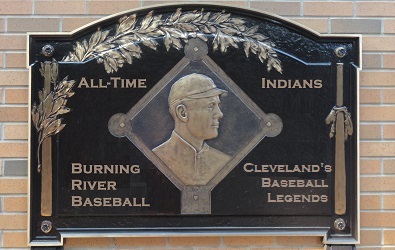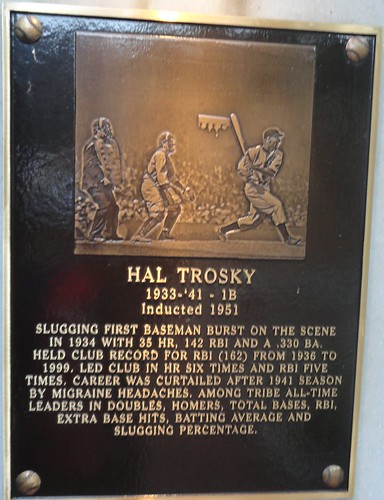| Name: | Harold Arthur Trosky, Sr. | Position: | First Base | |||||||||||||||
| Tribe Time: | 1933-1941 | Number: | 7 | |||||||||||||||
| Accolades: | Top 10 MVP (1934, 1936), Top 30 MVP (1938-39) | DOB: | 11/11/1912 | |||||||||||||||
| Stats | G | AB | R | H | 2B | 3B | HR | RBI | TB | BB | SO | SB | CS | SB% | OBP | SLG | AVG | OPS |
| Best Season (1936) | 151 | 629 | 124 | 216 | 45 | 9 | 42 | 162 | 405 | 57 | 58 | 6 | 5 | 55% | .382 | .644 | .343 | 1.026 |
| Indians Career | 1124 | 4365 | 758 | 1365 | 287 | 53 | 216 | 911 | 2406 | 449 | 373 | 21 | 18 | 54% | .377 | .551 | .313 | .928 |
Signed as an 18 year old out of Iowa in 1931, Hal Trosky and the Cleveland Indians were the perfect match at the perfect time. Beginning with the end of the dead ball era, essentially in 1920, offenses around the league exploded and they would continue to expand through 1941. Major League hitters shattered the MLB home run record in 1929 with 1,349, then broke that the next year with 1,565. A little more than a decade earlier, a player like Trosky may have been overlooked, but as the 1930’s roared in, every team wanted their Ruth.
Trosky quickly obliged, batting .322 and slugging .564 in the minors in 1932 and he would make his debut in 1933 at the age of 20 as a September call-up. The following season, after only eleven Major League games, Hal Trosky took over the first baseman’s role for the Tribe and didn’t relinquish it until he left the team in 1942.
Earl Averill had been the Indians top hitter since 1929, breaking the Indians single season home run mark that season (18), then again in 1932 (32) after Ed Morgan broke it in 1930 (26) and the career home run mark in 1932 as well. As great as Averill was, the Indians didn’t have another hitter anywhere near his talent level to fill out the line-up, with only Joe Vosmik and Odell Hale as above average hitters. Trosky changed that.
In his rookie year, he destroyed Averill’s single season home run mark with 35 as he played in all of the Indians 154 games. In addition, he hit 45 doubles and nine triples, knocking in 142, one short of the team record set by Averill in 1931. His 206 hits also lead the team as did his .330 average and .598 slugging percent. In terms of fWAR, this was the fourth best rookie season in Indians history (behind Shoeless Joe Jackson, Al Rosen and Kenny Lofton) and offensively it was the second best ever behind Jackson in 1911.
Of course, this offensive explosion wasn’t limited to Trosky. After hitting just 50 total home runs in 1933, the Indians doubled that total in 1934 to 100 with 79 coming from Averill, Trosky and Odell Hale (13). Vosmik only hit 9 out, but batted .341 in 104 games while Bill Knickerbocker had the greatest offensive season of his career by a landslide by batting .317 and slugging over .400. The Indians scored 160 more runs than the previous season, won 10 more games and improved one slot in the standings, moving up to third after four straight seasons finishing fourth in the eight team American League. While others had great seasons, no one made the difference that Trosky did, making the line-up more dangerous and improving the hitters around him through that.
Trosky would also play 154 games in 1935 to lead the league, but it would be the worst season of his short career. A sophomore slump of epic proportions, he hit only 26 home runs and knocked in just 113 as his slugging percent dipped 130 points. With 216 hits including 20 triples and 47 doubles, it was Vosmik’s turn to lead the team in all three slash stats and while the Indians maintained in third place for the second straight season, it was because of an increase in pitching production as the offense fell with Trosky.
Obviously, I was being a bit over dramatic in describing Trosky’s play as poor in 1935, but in 1936 he would make each of his first two seasons and every other season previously in Indians history look like Omar Infante trying to make an All-Star Game. Averill’s RBI mark that he had been so close to surpassing two years earlier was shattered with 162, a number that wouldn’t be neared until Manny Ramirez broke it in 1999, 63 years later. His .644 slugging percent was also a team record and it would last nearly as long, being broken in 1995 by Albert Belle, then again by Ramirez in 1999. He remains third all time in slugging percent and second in RBI. His 42 home runs beat his own record, although the new record wouldn’t stand anywhere near as long as the other two he set as Al Rosen hit 43 in 1953 and has since been pushed to eighth most in Indians history, tied with Rocky Colavito (1959) and Travis Hafner (2006).
In terms of pure power, this still remains arguably the greatest season for an Indians hitter ever and was certainly the best until 1995. As an overall hitter, Trosky also had 216 hits and 45 doubles. Forming one of the most epic duos in team history, Averill had 232 hits batting ahead of Trosky and scored 136 runs, nearing his team record of 140. Trosky was directly responsible for 49 of those runs. As a team, they scored 921, just four short of the team record set in 1921 and only the second time they had ever scored more than 900. They would only score more than 800 three times between 1939 and 1994 and wouldn’t hit 900 again until 1996. To show how difficult this feat truly has been, the Indians haven’t scored 800 runs since 2008 and 900 since 2000.
Interestingly enough, Trosky wasn’t even able to surpass his teammate in MVP voting that year, coming in tenth and losing to Lou Gehrig with Averill finishing third. He had come closer in his less impressive rookie year when he finished 7th, losing to Mickey Cochrane and finishing behind three other Tigers as well.
From 1937 through 1939, Trosky wouldn’t have as high of a peak, but would be the model of consistency, following in the path of Averill. During that span, he averaged a .321/.392/.557 slash line with 25 home runs, 36 doubles and 114 RBI per season. He wouldn’t surpass the 200 hit or 40 home run mark again, but he still knocked in and scored 100 in both 1937 and 1938 and knocked in 100 more in 1939. By the end of his Indians career, all this production would amount to quite a bit as he sat third in Indians history in RBI behind Averill with only Nap Lajoie between him and his partner in crime (Thome has since squished his way in between as well, but Trosky remains fourth all time).
Averill would be traded early in 1939, but not before cementing his career Indians home run record at 226. Trosky wouldn’t reach this mark, but his 216 was enough for second, destroying number three on the list at the time, Tris Speaker‘s 73. While ultimately both Trosky and Averill (still back-to-back in the rankings) have been surpassed three times, it didn’t happen until Belle reached 242 in 1996.
In 1940, Trosky was 27 and should have been heading into his prime. With another 25 home runs, 93 RBI and a .295/.392/.529 slash, it appeared this could go on forever. If he would have played through his mid-30’s he would have set records so high they would never have been touched. However, the 1940 season would be his last full season for the Tribe. After playing only 89 games in another otherwise great season in 1941, Trosky retired due to severe migraines. After moving back to Iowa, the pain receded enough by 1944 to give it another try and the Indians sold Trosky to the White Sox so he could play for the team closest to home. There, he had a season that showed he probably could have continued hitting at the level he was. After spending two years without swinging a bat, Trosky came out of retirement to lead the White Sox with 32 doubles in 135 games. After missing all of 1944, he would attempt a second comeback in Chicago in 1945, but he would play just 88 games. At the age of 33, a potential Hall of Fame career ended after just 11 years and eight full seasons.
At his hottest, no one could touch Trosky, but as they say, the flame that burns twice as bright burns half as long. Although his career was short (too short for Hall of Fame consideration), he did leave his mark on the Indians and he still holds spots in the top ten for career OPS, total bases and doubles and the top five for slugging percent. Still one of the greatest first basemen in Indians history, Hal Trosky was inducted into the Cleveland Indians Hall of Fame in the inaugural class of 1951. He died in 1979 in his home state of Iowa.
Add The Sports Daily to your Google News Feed!

